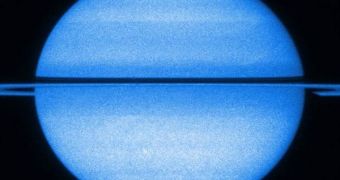The refurbished Hubble Space Telescope is now more apt at conducting astronomical observations than ever before, despite its old age. While investigating the gas giant Saturn, it managed to capture a unique glimpse of the phenomena going on at the planet's poles. It captured the new film while the celestial body was located edge-on in respect to the venerable telescope's observing position, which means that it gained a spectacular perspective on the poles, and the auroras that adorn them. Saturn also has an active magnetic field, similar to that on Earth, which blocks incoming solar radiation, and gives birth to the amazing light shows, Space reports.
Such observations of the gas giant can only be taken on very rare occasions. It takes about 30 years for Saturn to circle the Sun once, and edge-on views can only be captured during equinoxes, time periods when sunlight falls directly on its equator. This happens once every 15 years, and the planet is currently getting ready to shift its orientation as opposed to Earth. The data for the new video was collected in a series of photographs taken between January and March 2009, as the gas giant reached the most favorable position for astronomical studies.
Unfortunately, this film is probably the last Hubble will ever provide of Saturn. In spite of its upgrade, the telescope is nearly 20 years old, having been launched on April 24, 1990. It is very unlikely that it will endure for an additional 15 years, until the next equinox. During these years, Hubble became the iconic image of space exploration, producing images that now elicit warm memories in people who were young when it was launched. It is scheduled to remain in active duty until at least 2014, thanks to the new improvements, when it will be replaced by the James Webb Space Telescope, the largest and most powerful observatory every built.
By analyzing the fresh footage, astronomers and astrophysicists were able to gather important details on how Saturn's magnetic field is organized. Theoretically, it should have had equal concentrations of particles both at the North and South poles, but an insightful analysis revealed that this is not the case. This means that the field is not equally distributed across the gas giant. The North pole experiences a smaller and more intense auroral oval than its southern counterpart, the researchers say. The new findings are in tune with data supplied by the NASA/ESA Cassini spacecraft, which has been orbiting the planet since 2004.

 14 DAY TRIAL //
14 DAY TRIAL //